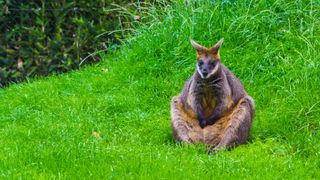This adorable animal spends its entire adult life pregnant
Swamp wallaby females can remain pregnant through their entire adult lifetimes.

Pregnancy can sometimes feel like it lasts forever, but for an Australian marsupial called a swamp wallaby (Wallabia bicolor), pregnancy truly never ends.
Researchers recently discovered that female wallabies can conceive while still pregnant, implanting a new embryo — or two — days before giving birth to an existing fetus — or two.
This creates a cycle of perpetual pregnancy that persists throughout the wallabies' lives as sexually mature adults. It's also a reproductive strategy that is one of a kind among mammals, scientists reported in a new study.
Related: Marsupial gallery: a pouchful of cute
Swamp wallabies, which stand about 2 feet (70 centimeters) tall, are native to eastern Australia, where they live in forests and swamps. They become sexually mature at 15 months old, can breed year-round and have a gestation period that lasts 33 to 38 days, according to the University of Michigan's Museum of Zoology.
However, the wallabies' estrus cycle is only 31 days long, scientists wrote in the new study, published online March 2 in the journal Proceedings of the National Academy of Sciences.
Mammalian reproduction includes four stages: ovulation, fertilization, pregnancy and lactation. In a group of marsupials called macropodids, which includes kangaroos and wallabies, certain species experience ovulation shortly after birth — sometimes within hours, the study authors wrote. Because swamp wallabies' estrus cycle is shorter than their gestation period, researchers had long suspected that mating and conception for these animals might overlap with pregnancy.
Sign up for the Live Science daily newsletter now
Get the world’s most fascinating discoveries delivered straight to your inbox.
To find out if that was the case, scientists with Australia's University of Melbourne and the Leibniz Institute for Zoo and Wildlife Research in Berlin collected vaginal smears and conducted high-resolution ultrasounds of pregnant wallabies.
They found that 90% of the pregnant females were actually doubly pregnant, carrying a second embryo fertilized from ovulation that took place when their full-term fetus had already completed 97% to 100% of its gestation.
But the fetuses weren't womb-mates. Marsupial females have twin uteri (along with three vaginas). This means that a pregnant swamp wallaby, days away from delivering a fetus in one uterus, can ovulate, mate and develop a newly fertilized embryo in her second uterus.
However, that second fetus doesn't start developing yet, according to the study. Marsupials deliver their young at a much earlier developmental stage than other mammals, and their joeys have months of lactation and growth ahead of them. While the newborn is nursing the embryo is "paused" in the womb, and its development doesn't begin until lactation of its sibling ends and the baby leaves their mother's pouch.
"These results clearly demonstrate that the swamp wallaby conceives a new embryo before birth," the scientists wrote. This reproduction strategy "completely blurs the normal staged system of reproduction in mammals."
- Photos: world's cutest baby wild animals
- The 12 weirdest animal discoveries
- Image gallery: evolution's most extreme mammals
Originally published on Live Science.
<a href="https://myfavouritemagazines.pxf.io/c/221109/583111/9620?subId1=hawk-custom-tracking&sharedId=hawk&u=https%3A%2F%2Fwww.myfavouritemagazines.co.uk%2FHIW%2FLIVE2020w" data-link-merchant="myfavouritemagazines.co.uk"" target="_blank">OFFER: Save at least 53% with our latest magazine deal!
With impressive cutaway illustrations that show how things function, and mindblowing photography of the world’s most inspiring spectacles, <a href="https://www.space.com/43211-how-it-works-magazine-free-issue.html" data-link-merchant="space.com"" data-link-merchant="myfavouritemagazines.co.uk"">How It Works represents the pinnacle of engaging, factual fun for a mainstream audience keen to keep up with the latest tech and the most impressive phenomena on the planet and beyond. Written and presented in a style that makes even the most complex subjects interesting and easy to understand, <a href="https://www.space.com/43211-how-it-works-magazine-free-issue.html" data-link-merchant="space.com"" data-link-merchant="space.com"" data-link-merchant="myfavouritemagazines.co.uk"">How It Works is enjoyed by readers of all ages.

Mindy Weisberger is an editor at Scholastic and a former Live Science channel editor and senior writer. She has reported on general science, covering climate change, paleontology, biology, and space. Mindy studied film at Columbia University; prior to Live Science she produced, wrote and directed media for the American Museum of Natural History in New York City. Her videos about dinosaurs, astrophysics, biodiversity and evolution appear in museums and science centers worldwide, earning awards such as the CINE Golden Eagle and the Communicator Award of Excellence. Her writing has also appeared in Scientific American, The Washington Post and How It Works Magazine.
Most Popular


